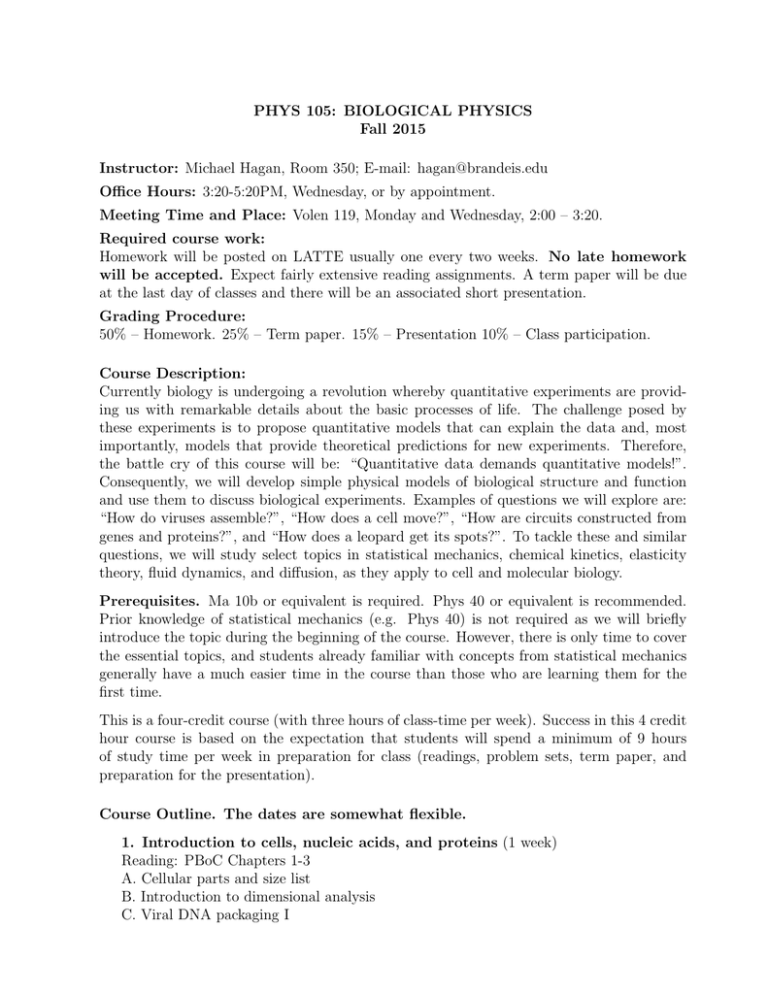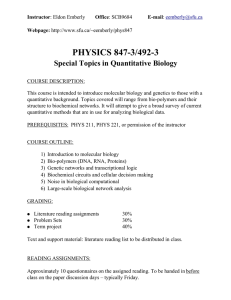PHYS 105: BIOLOGICAL PHYSICS Fall 2015 Instructor: Michael Hagan, Room 350; E-mail:
advertisement

PHYS 105: BIOLOGICAL PHYSICS Fall 2015 Instructor: Michael Hagan, Room 350; E-mail: hagan@brandeis.edu Office Hours: 3:20-5:20PM, Wednesday, or by appointment. Meeting Time and Place: Volen 119, Monday and Wednesday, 2:00 – 3:20. Required course work: Homework will be posted on LATTE usually one every two weeks. No late homework will be accepted. Expect fairly extensive reading assignments. A term paper will be due at the last day of classes and there will be an associated short presentation. Grading Procedure: 50% – Homework. 25% – Term paper. 15% – Presentation 10% – Class participation. Course Description: Currently biology is undergoing a revolution whereby quantitative experiments are providing us with remarkable details about the basic processes of life. The challenge posed by these experiments is to propose quantitative models that can explain the data and, most importantly, models that provide theoretical predictions for new experiments. Therefore, the battle cry of this course will be: “Quantitative data demands quantitative models!”. Consequently, we will develop simple physical models of biological structure and function and use them to discuss biological experiments. Examples of questions we will explore are: “How do viruses assemble?”, “How does a cell move?”, “How are circuits constructed from genes and proteins?”, and “How does a leopard get its spots?”. To tackle these and similar questions, we will study select topics in statistical mechanics, chemical kinetics, elasticity theory, fluid dynamics, and diffusion, as they apply to cell and molecular biology. Prerequisites. Ma 10b or equivalent is required. Phys 40 or equivalent is recommended. Prior knowledge of statistical mechanics (e.g. Phys 40) is not required as we will briefly introduce the topic during the beginning of the course. However, there is only time to cover the essential topics, and students already familiar with concepts from statistical mechanics generally have a much easier time in the course than those who are learning them for the first time. This is a four-credit course (with three hours of class-time per week). Success in this 4 credit hour course is based on the expectation that students will spend a minimum of 9 hours of study time per week in preparation for class (readings, problem sets, term paper, and preparation for the presentation). Course Outline. The dates are somewhat flexible. 1. Introduction to cells, nucleic acids, and proteins (1 week) Reading: PBoC Chapters 1-3 A. Cellular parts and size list B. Introduction to dimensional analysis C. Viral DNA packaging I 2. Statistical Mechanics, Ligand Binding, and Transcription Regulation) (2 weeks) Reading: PBoC Chapters 5 and 6, Ch 7.2.4 (pages 298-305), and Ch 19, up to the end of 19.2 (pgs 801-832) A. Boltzman’s formula and protein-DNA binding. B. Regulation of gene expression. 3. Gene Circuits (1 week) Reading: Chapter 15 573-596, Chapter 19 835-870 (the rest of the chapter 870-892 is also good reading) A. Chemical kinetics and genetic circuits. B. Lambda phage switch 4. Biological electricity – Electrostatics in Salty Solution (2 weeks) Reading: Ch. 9 PBoC A. Rapid review of electrostatics in vacuum and pure solution (Poisson’s equation) B. Electrostatics in salty solution (Poisson-Boltzmann equation) C. Viral DNA packaging II 5. Biological elasticity in 1D – Beam theory and bending of semiflexible polymers (2 weeks) reading: Ch. 10 PBoC, Ch. 8 PBoC A. Young’s modulus, persistence length, worm-like chain model B. Entropy of the ideal polymer C. Viral DNA packaging III 6. Matlab Tutorial (0.5 weeks) 7. Biological elasticity in 2D – Membranes (1.5 weeks) reading: Ch. 12 PBoC A. Free energy to stretch, shear, or bend a membrane B. Experiments to determine membrane stretching and bending moduli C. Modeling receptor-mediated endocytosis 8. How cells make patterns (3 weeks) Reading: PBoC Chapter 20 A. How an E.coli cell finds it middle. B. The diffusion equation C. Reaction diffusion equations and Turing patterns D. Mammalian pattern formation–How a leopard gets its spots E. Numerical solution of ordinary and partial differential equations using finite differences (Matlab) F. How the fly embryo gets its stripes. Learning goals By the end of this course, students from the life science will have been exposed to statistical mechanics and those from the physical sciences will have an introduction to biological systems. Furthermore, students will begin to appreciate how physical forces drive and control biological phenomena. Suggested reading 1. R. Phillips, J. Kondev and J. Theriot Physical Biology of the Cell (Garland Science, 2013, 2nd ed.). This is the primary text that the course will follow. It is a fantastic book, and highly recommended. The first edition (2008) is also available, but it is black and white only (less important) and does not contain some important chapters, particularly a chapter on pattern formation (more important). 2. B. Alberts et al., Essential Cell Biology 3rd Ed. (Garland Science, 2012). This book will be a great complement, as it provides detail about the biological systems we study which goes well beyond what can be presented within an hour and a half lecture. 3. K. Dill and S. Bromberg, 2nd Ed. Molecular Driving Forces, (Garland Science, 2012). This book provides an introduction to statistical mechanics and thermodynamics, in an accessible manner. 4. Steven H. Strogatz, Nonlinear Dynamics and Chaos: With Applications to Physics, Biology, Chemistry, and Engineering (Perseus Books Publishing, LLC ,1994) 5. J.D. Murray, Mathematical Biology, Vols I and II, 3rd Ed. (Springer, 2003)






